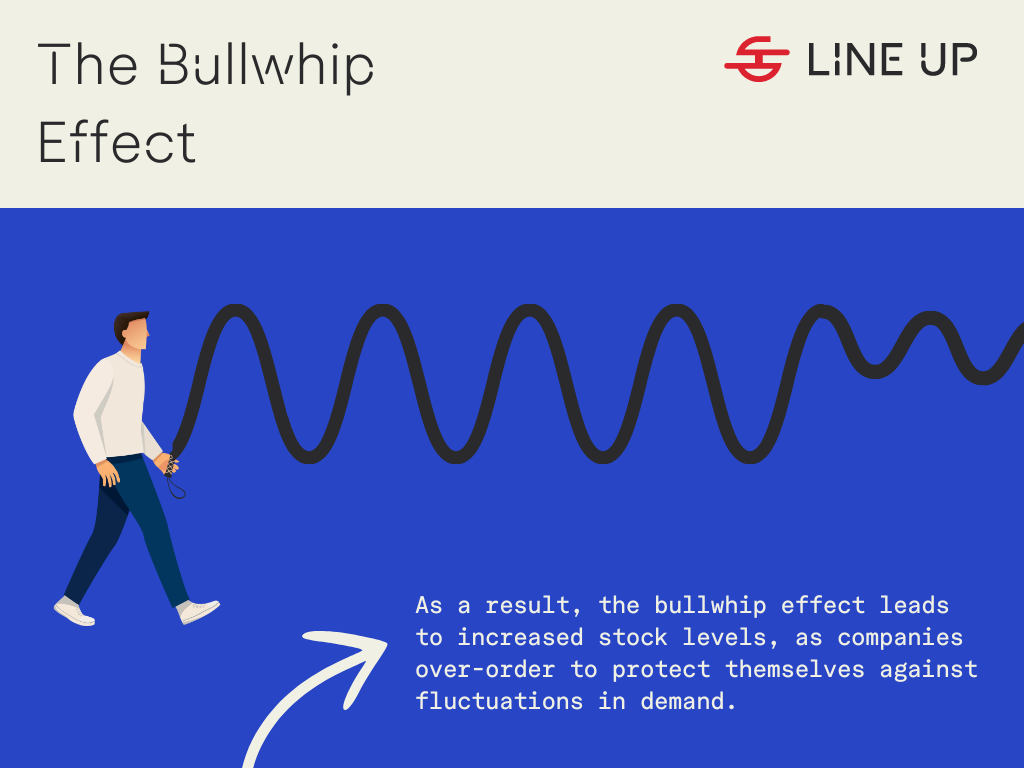Table of Contents
- What is the bullwhip effect?
- 5 factors that lead to the bullwhip effect
- How does the bullwhip effect impact the supply chain?
- How can the bullwhip effect be prevented?
- How does the digital supply chain influence the bullwhip effect?
- Why real-time data is becoming increasingly important
- Optimise your supply chain management with Line Up
Logistics planning: preventing the bullwhip effect
Reading Time: 5 min.

As logistics planning becomes ever more complex, the bullwhip effect can act like an invisible whip that confronts companies with major challenges. We reveal how you can prevent it and what role digital supply chain management plays in this.
As companies operate on a global scale and supply chains are becoming increasingly complex, supply chain management has become much more important in recent decades. A key phenomenon that increases this complexity is the so-called bullwhip effect, which often leads to considerable problems in supply chains.
What is the bullwhip effect?
The bullwhip effect describes a phenomenon in the supply chain in which even small changes in end consumer demand lead to disproportionate fluctuations in orders and production.
This is caused by several factors: on the one hand, delayed information about actual demand leads companies to adjust their orders disproportionately in order to prevent supposed bottlenecks. Secondly, safety stocks and inaccurate forecasts increase fluctuations in production.
If, for example, a retailer notices an increase in demand, it could significantly increase its orders with the wholesaler. The wholesaler interprets this as a long-term trend and in turn adjusts its orders with the manufacturer accordingly, leading to a chain reaction and thus the bullwhip effect.
5 factors that lead to the bullwhip effect
1. incorrect demand forecasts
Incomplete or incorrect forecasts of customer demand can lead to too much or too little being ordered. A lack of information transparency in the supply chain exacerbates this effect, as companies are reliant on outdated or inaccurate data.
2. price fluctuations
Companies often use discount campaigns or expect price changes, which leads to an unnaturally high order volume that does not correspond to actual demand. This pricing leads to unpredictable peaks in demand and reinforces the bullwhip effect.
3. order quantity policy
Many companies use fixed order sizes or intervals to optimise their logistics processing, production costs and storage costs. However, such a procurement strategy can also mean that orders do not correspond to actual demand.
4. time delays
Delays in the transmission of information along the supply chain or in the delivery of goods exacerbate the problem. For example, a company that receives information about a change in demand too late can overreact by ordering more than necessary.
5. safety stock
In order to protect themselves against unforeseen fluctuations in demand, many companies build up high safety stocks. However, this increases the risk of over-ordering, which in turn increases the bullwhip effect.
How does the bullwhip effect impact the supply chain?
As a result, the bullwhip effect leads to increased stock levels, as companies over-order to protect themselves against fluctuations in demand. And as additional storage space is required and capital is tied up in surplus products, storage costs increase.
Logistics planning and logistics processing can also come under pressure due to the bullwhip effect: The increased transport and storage requirements overstretch capacities, leading to longer delivery times and inefficient processes.
The bullwhip effect also has a negative impact on customer satisfaction due to delivery delays or insufficient availability of goods: Companies are unable to deliver products on time due to over-ordering or have to keep customers waiting, which can affect trust in the brand.

How can the bullwhip effect be prevented?
In order to prevent the bullwhip effect, several strategies are required, which are primarily aimed at improving the distribution of information and optimising cooperation within the supply chain. One key approach is to improve communication between the various players - especially between manufacturers, wholesalers and retailers.
Improved information transparency
End-to-end, transparent communication along the supply chain is crucial. Modern technologies such as supply chain dashboards can make it possible to share real-time data and thus ensure that everyone is informed about current changes in demand.
Just-in-time delivery
The just-in-time production strategy ensures that companies produce or order exactly the quantity they need based on actual demand.
Joint demand planning
Another important aspect is the implementation of joint forecasting tools that enable all partners to make decisions on production and order quantities based on the same data.
Flexibility in production
The development of flexible manufacturing techniques and agile production capacities enables manufacturers to react quickly to fluctuations in demand without having to ramp up production excessively.
Integrative approach
Last but not least, it is important to design incentives in such a way that they encourage cooperative behaviour rather than focusing on individual advantages.
How does the digital supply chain influence the bullwhip effect?
The digital supply chain helps to reduce the bullwhip effect through the use of modern technologies such as big data, artificial intelligence (AI) and the Internet of Things (IoT). They enable well-founded decisions and optimise processes in the supply chain, resulting in more efficient planning.
Supply chain dashboards, for example, can provide a real-time overview and thus increase information transparency, enabling companies to react quickly to changes in customer demand. Automation and data analysis can also be used to accurately predict changes in demand and optimise order quantities, further mitigating the bullwhip effect.
In addition, technologies based on blockchain can enable even greater transparency, while demand forecasts will become increasingly precise in future thanks to AI and machine learning. Flexible production systems and the increased use of IoT can also ensure that supply chains become even more efficient.
Why real-time data is becoming increasingly important
Above all, it is real-time data that plays a central role in digital supply chain management. Analysing this data makes it possible to create precise demand forecasts and reduce fluctuations in production and logistics. And this transparency ultimately promotes smooth collaboration along the entire supply chain and minimises the risk of over- or under-ordering. This allows companies to react more quickly to market changes and actively prevent potential whiplash effects, which significantly increases the efficiency of processes.
Optimise your supply chain management with Line Up
It is clear that the bullwhip effect is one of the biggest challenges in supply chain management. However, it is also clear that modern technologies and a digital supply chain help to get the chain reaction under control.
In addition to the measures mentioned above, comprehensive cooperation strategies between companies and their suppliers are also essential. Open and transparent communication plays a key role here, as it helps to exchange information about demand in a precise and timely manner. In addition, close co-operation not only promotes understanding of the respective needs, but also reduces uncertainties that often lead to overstocking or bottlenecks.
Do you have any questions on this topic or would you like to find out more about the bullwhip effect? Do not hesitate to contact us at any time.
Newsletter Registration
Sign up now for our free Line Up newsletter and stay up to date.





